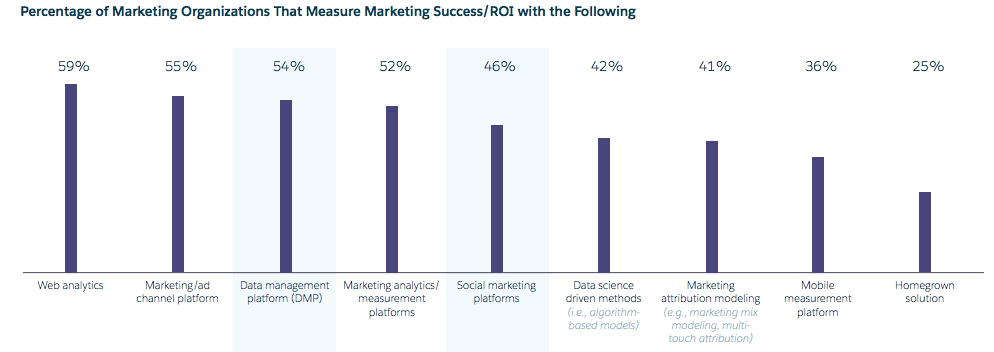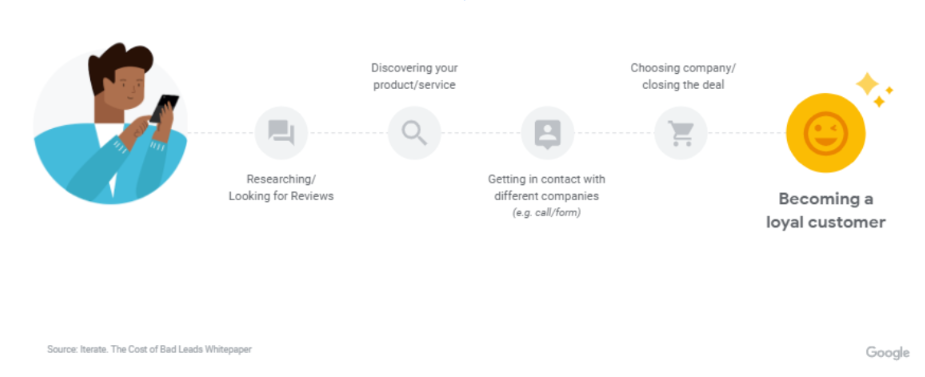
Today’s marketing landscape has expanded more than ever. This includes how we conduct our business and meet the customers’ expectations. The average customer journey consists of many steps, weaving between the online and offline worlds.
Companies and customers interact across various channels, including email, phone, social media, and in-store interactions. Customers also expect that brands are available on all sites, at all times. 40% of people don’t do business with a company if it’s not present on their preferred marketplace.
Also, 79% of internet users make purchases via smartphones. That’s why it’s a must for companies to maintain their online presence if they want to stay relevant to modern shoppers.
- What is a marketing attribution model?
- Types of marketing attribution models
- Best marketing attribution models based on your needs
- How to build a marketing attribution model?
- How to measure marketing attribution
- Understanding the Facebook attribution model
- Google Offline Conversion Tracking
- Marketing mix modeling vs. attribution
- Key takeaways
In this article, we’ll discuss attribution modeling, along with the various types available for use. Additionally, we’ll talk about how integrating Facebook Conversions API (CAPI) can improve your advertising performance as well as user experience.
You’ll also get some insights into how LeadsBridge’s Facebook CAPI integrations help automate your workflows. These integrations basically create a direct data bridge between your marketing data and the marketing apps you use every day. Schedule a demo to find out all you need to know.
What is a marketing attribution model?
The customer journey is complex and is scattered across a number of touchpoints. So, it can be challenging for companies to effectively track these highly fragmented journeys and offer seamless user experiences.
Marketers use a marketing attribution model to overcome this issue by tracking each step a user takes toward a purchase. According to a Salesforce survey carried out among 4,100 marketing leaders, 41% of organizations now measure ROI (return-on-investment) with a marketing attribution model.

A marketing attribution model is a systematic way to measure and assign the value of specific touch points along the consumer journey. This strategy enables businesses to see which channels hold the highest value in regard to customer conversion.
Each model provides a specific scope of insight into how a customer interacts with your marketing messaging. This includes which channels and how often.
These details allow you to optimize campaigns to better target individual customers. Accordingly, these enriched strategies lead to higher conversion, driving a greater ROI for your business.
Types of marketing attribution models
There are numerous marketing attribution models to choose from. Some models assign a value to all touchpoints, whereas some credit selected or singular events.
Let’s take a closer look at some of the most widely used variations;
The single-touch attribution model
First touch attribution model
This is a rules-based marketing attribution model. The first interaction in a customer’s journey is the one that receives 100% of the attribution credit for the conversion. This is most often used for measuring marketing efforts in reaching new customers.
For example, let’s say that you have purchased a PPC ad on paid search. This touch point will receive all the conversion credit going forward, even if the user interacted with other touch points along the way.

Last touch attribution model
The last touch attribution operates exactly like first-touch, except the credit is given to the last interaction in a customer’s journey. This model is typically used to establish the value of the final touchpoint.
A good example of this marketing attribution model would be if a customer saw an advertisement for your brand on Facebook and then viewed your product on your main site. However, they decided not to buy it.
This customer then went on to see a billboard ad for your product, and made a purchase. Based on the last-touch model, the billboard will receive all the conversion credit.
The rule-based multi-touch attribution model
Linear attribution model
In a linear marketing attribution model, each point in a customer’s journey is given even credit for the event of a conversion. In long consideration cycles, this is typically a marketer’s model of choice. This is due to the importance of reinforcing the message multiple times throughout the attribution process.

Position-based model
Alternatively known as the u-shaped model, position-based attribution gives higher credit to the first and last touchpoint in the customer’s journey. While all touch points are monitored and acknowledged, this model typically favors the first and last touchpoints.
Time Decay model
In a time-decay marketing attribution model, the credit percentage slowly increases as the conversion time becomes closer. It reflects the value of all touchpoints in the entire journey, but the most recent receive higher credit. Marketers typically use this model for efforts that have shorter consideration cycles.

Algorithm-based attribution model
Incremental attribution
With this model, the impact that media advertising spending provides on the conversion rate is measured in ‘increments’. Marketers use this to determine if campaigns, creative projects, and placements are performing well and if they are truly influencing conversions.
Fractional attribution
Using machine learning, a fractional marketing attribution model gives partial credit to every touchpoint a customer interacts with. Dimensions such as images, content placement, and included promotions are factored into the algorithm. This helps to inform future marketing spending. Detailed data allows for the determination of which channels deserve specific percentages.

Best marketing attribution models based on your needs
It’s important to realize the set of objectives and expectations of how you want your marketing efforts to evolve. This will help you choose the right attribution model for your business. Once you have defined your company’s needs, there are four key points to consider when making your choice.
These points are as follows:
Primary objectives
What’s your main objectives and what are you trying to measure? This will be a major deciding factor on which marketing attribution model to implement and use in your marketing reports.
If your goal is to generate more demand, the first touch attribution model is a fitting choice. Measuring conversions? The last touch model might be the optimal approach. Do you want to measure attribution throughout the entire funnel? The linear model is the best option for this instance.
Target channel
Depending on your chosen target channel, you will have a few marketing attribution model options at your disposal.
If you are focusing on SEO as a single channel, a linear attribution model would not make sense. Because it’s typically multi-touch. However, the last touch attribution model would probably be a good pick for you.
Touchpoints
How effective your marketing attribution model will depend almost entirely on the number of touchpoints in your sales cycle. If it gets overly complicated, a simple first touch or last touch attribution model would be among the best choices.
Learn all you need to know about customer lifecycle automation here.
Sales cycle length
The length of the sales cycle also plays a vital role in choosing the correct marketing attribution model for your needs. Simply put, you need a model that will stick with you for the entirety of the cycle. Due to the limited time that tracking cookies are effective in a first touch attribution, a time-decay model would be better suited.
How to build a marketing attribution model?
Building a marketing attribution model is set upon a main point: finding the touchpoints a consumer interacts with before making a purchase or conversion.
Wondering how to build a marketing attribution model that is both efficient and accurate? You should first take a step back. Start by collecting ample data across all your marketing channels and customer touchpoints.
Then, analyze the customer journey to understand how each interaction affected the conversion process. Considering the results, you can choose an attribution model—such as last-click, first-click, linear, time-decay, or a custom model—that best matches the buying behavior of your target audience and your marketing objectives.
However, choosing a model is not enough. You’ll need to implement your model in the best way possible. This calls for integrating data analytics tools and software that can track and assign value to each touchpoint. Automated data bridges allow you to make informed decisions on how to best allocate your marketing budget.
How to measure marketing attribution
For measuring marketing attribution, you need to use advanced analytics tools. These tools help you track, collect, and analyze data from all marketing channels and customer interactions. This process is rather complex involving setting up conversion tracking to identify which marketing efforts lead to sales or desired actions.
A high-performing analytics platform helps you:
- Attribute value to each touchpoint in your customer journey
- Analyze the contribution of different channels
- Impact of campaigns on conversions.
Your job is to review and interpret this data, which allows you to understand the effectiveness of your strategies. Only then can you optimize your campaign’s performance and reallocate resources to maximize ROI. Effective measurement also means testing different attribution models and continuously refining your approach.
Understanding the Facebook attribution model
The way Facebook tracks ad data has changed dramatically over time. This started with the iOS 14 update which severely hindered how we view the full performance data associated with our advertising.
The vast amounts of information we once had, have now been dwindled down to simple estimations. Due to the new update, we can only view the last event that took place, which is purchasing.

This has led the Facebook Ads attribution model to change, and begin a new process called data modeling. This involves establishing a model based on the available data sets we have from iOS 14 devices and non-iOS 14 devices. This data goes to reports, and then to optimization for campaign conversion goals.
However, the data is not deterministic. It means that conversions are being attributed to certain campaigns and ads based on probability.
Integrating Facebook’s Conversion API tool helps you regain some control of our data tracking and deliver more targeted experiences to our audiences.
This tool enables you to acquire valuable insights when it comes to online or offline conversion tracking through a server connection. In practice, you can use Facebook Conversions API to manage the data that is shared between your database and Facebook servers.
This way, you can accurately track offline conversions, such as physical store purchases, and optimize your campaigns accordingly. Meta suggests combining Facebook Conversions API with Pixel to improve data accuracy and optimizations, particularly for lower-funnel events.
We are talking about a cookie-less solution that allows you to transfer data directly from your CRM. However, you must consider user consent as an integral part of your Facebook marketing since CAPI is not a means of bypassing privacy regulations.
Find out more about consent marketing practices on Facebook here.
The importance of online to offline conversion tracking
Using offline to online conversion tracking allows you to better detect how consumers move through your sales funnel. This enables you to improve the customer purchasing journey by establishing which advertising campaigns are the most effective.ù
By analyzing the data from offline conversions, you can provide a more targeted user experience and increase conversions. For example, this can be done by identifying which time of the day or day of the week offers the highest engagement. So you can communicate with users at a time that is best aligned with their behaviors.
Online-to-offline tracking is simple to set up for platforms such as Facebook and Google, Given you use the right tools and integrations.
Online to offline attribution with Facebook Conversion API via LeadsBridge
Using Facebook Conversions API can have many advantages for your business, as you can leverage this data to boost your digital campaigns. You can get access to reporting that showcases who have engaged with your ads and interacted with your business via an offline channel.
With online to offline attribution, you are afforded the opportunity to create custom audiences. This lets you effectively retarget customers who have engaged with your business in the offline world, like a physical store. Doing so allows for the full tailoring of your advertising efforts, ultimately boosting your end conversions.
LeadsBridge offers an Offline Conversions Sync tool. It bridges the gap between your online and offline sales and puts your attribution tracking back on track with ease. Here’s how it works in just five easy steps:
- Users watch or click on your Facebook Ads
- The same users then go on to purchase your product in an offline setting
- LeadsBridge automatically bridges your CRM/POS/Inventory with Facebook
- Facebook matches your purchase data with advertising data
- Facebook will then report all influenced offline sales to your dashboards
Google Offline Conversion Tracking
Google Offline Conversion Tracking is an advertising tool that can facilitate tracking of offline Google Ads sales, as well as additional vital mid-funnel offline conversions. This includes submissions, downloads or phone calls.
This feature allows you to import conversions that are tracked in another system, such as the company’s CRM, into Google Ads. This means that you can better ascertain lead quality according to the volume of offline sales that have been generated.
How to use Google Offline Conversion Tracking
Using the Google Offline Conversions Tracking is quite simple. You must enable the auto-tagging feature within your Google Ads account. Google will then supply you with a unique Google ClickID (GCLID) for every ad click.
When users click on an ad and submit a form on your site, they will become a lead for your business. The GCLID containing your lead information can then be stored within your CRM platform.
Once the lead has been collected, all data concerning sales details, the GCLIDs or any other conversion action can be uploaded to Google Ads. Tracking these conversions will not only help improve lead quality, but it will go toward reducing your CPA, and increasing your profits.

Join the waiting list to discover how you can make your Google Offline Conversions Tracking even more efficient through LeadsBridge.
All of this is automated, so there’s no need for any manual importations or extra headaches. Thanks to our Offline Conversions Sync, users can track offline conversions generated through Facebook and Google by automatically syncing their marketing technology stack with the advertising platform.
Marketing mix modeling vs. attribution
Basically, marketing mix modeling (MMM) and attribution modeling are different insights into marketing performance.
Marketing Mix Modeling (MMM) is a top-down approach that analyzes historical data to see how effective the overall marketing channels are in sales or other outcomes. It’s measured over a longer period and often accounts for external factors like economic conditions or competitor actions. It’s mostly used to direct budgets to certain channels and understand long-term trends.
However, MMM may not provide granular insights into the customer journey or practicality of a real-time digital campaign. That’s where attribution modeling is used.
It’s a bottom-up approach that focuses on assigning credit to specific touchpoints or interactions in the customer journey. It offers detailed insights into the performance of digital marketing efforts. This model is better for optimizing digital campaigns and understanding immediate impacts. However, it may overlook offline channels and external factors that can influence consumer behavior.
When considering marketing mix modeling vs. attribution, You can see that each method has its pros and cons. MMM is best for strategic planning and budget allocation, while attribution modeling is more appropriate for campaign optimization.
Key takeaways
Regardless of the marketing attribution model, a multi-touch approach helps marketing managers to assess data at granular levels. The impact of advertising efforts can then be assigned to each or multiple touchpoints.
By applying the appropriate marketing attribution model, businesses can focus their efforts and plan the evolution of their marketing strategies accordingly.
As consumers explore new channels and companies develop, attribution and attribution tracking will become increasingly important for revenue generation. While each of the models listed above is helpful, the ultimate and most useful strategy will be a tailor-made approach to the needs of your business.
Seamlessly bridge the gap between your online and offline conversion with LeadsBridge integrations.


















